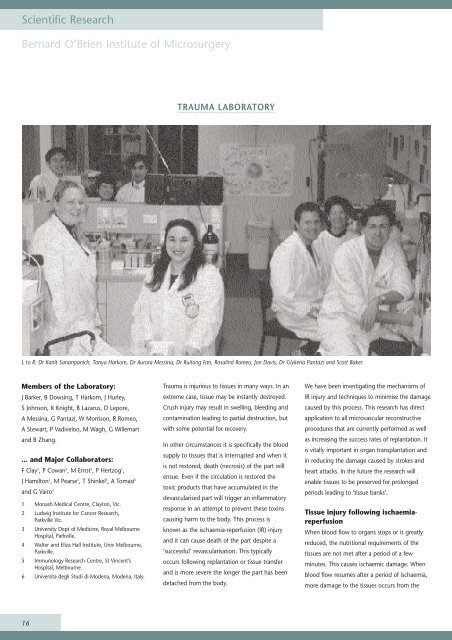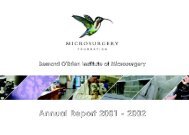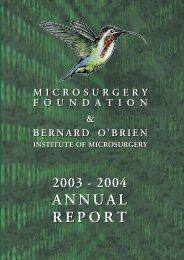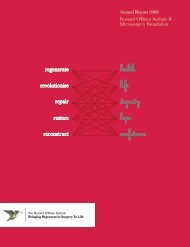2990 Microsurgery.qxd - O'Brien Institute
2990 Microsurgery.qxd - O'Brien Institute
2990 Microsurgery.qxd - O'Brien Institute
You also want an ePaper? Increase the reach of your titles
YUMPU automatically turns print PDFs into web optimized ePapers that Google loves.
Scientific Research<br />
Bernard O’Brien <strong>Institute</strong> of <strong>Microsurgery</strong><br />
TRAUMA LABORATORY<br />
L to R: Dr Kanit Sananpanich, Tanya Harkom, Dr Aurora Messina, Dr Ruitong Fan, Rosalind Romeo, Jon Davis, Dr Glykeria Pantazi and Scott Baker.<br />
Members of the Laboratory:<br />
J Barker, B Dowsing, T Harkom, J Hurley,<br />
S Johnson, K Knight, B Lazarus, D Lepore,<br />
A Messina, G Pantazi, W Morrison, R Romeo,<br />
A Stewart, P Vadiveloo, M Wagh, G Willemart<br />
and B Zhang.<br />
... and Major Collaborators:<br />
F Clay 2 , P Cowan 5 , M Ernst 2 , P Hertzog 1 ,<br />
J Hamilton 3 , M Pearse 5 , T Shinkel 5 , A Tomasi 6<br />
and G Vairo 4<br />
1 Monash Medical Centre, Clayton, Vic.<br />
2 Ludwig <strong>Institute</strong> for Cancer Research,<br />
Parkville Vic.<br />
3 University Dept of Medicine, Royal Melbourne<br />
Hospital, Parkville.<br />
4 Walter and Eliza Hall <strong>Institute</strong>, Univ Melbourne,<br />
Parkville.<br />
5 Immunology Research Centre, St Vincent’s<br />
Hospital, Melbourne.<br />
6 Universita degli Studi di Modena, Modena, Italy.<br />
Trauma is injurious to tissues in many ways. In an<br />
extreme case, tissue may be instantly destroyed.<br />
Crush injury may result in swelling, bleeding and<br />
contamination leading to partial destruction, but<br />
with some potential for recovery.<br />
In other circumstances it is specifically the blood<br />
supply to tissues that is interrupted and when it<br />
is not restored, death (necrosis) of the part will<br />
ensue. Even if the circulation is restored the<br />
toxic products that have accumulated in the<br />
devascularised part will trigger an inflammatory<br />
response in an attempt to prevent these toxins<br />
causing harm to the body. This process is<br />
known as the ischaemia-reperfusion (IR) injury<br />
and it can cause death of the part despite a<br />
‘successful’ revascularisation. This typically<br />
occurs following replantation or tissue transfer<br />
and is more severe the longer the part has been<br />
detached from the body.<br />
We have been investigating the mechanisms of<br />
IR injury and techniques to minimise the damage<br />
caused by this process. This research has direct<br />
application to all microvascular reconstructive<br />
procedures that are currently performed as well<br />
as increasing the success rates of replantation. It<br />
is vitally important in organ transplantation and<br />
in reducing the damage caused by strokes and<br />
heart attacks. In the future the research will<br />
enable tissues to be preserved for prolonged<br />
periods leading to ‘tissue banks’.<br />
Tissue injury following ischaemiareperfusion<br />
When blood flow to organs stops or is greatly<br />
reduced, the nutritional requirements of the<br />
tissues are not met after a period of a few<br />
minutes. This causes ischaemic damage. When<br />
blood flow resumes after a period of ischaemia,<br />
more damage to the tissues occurs from the<br />
16






